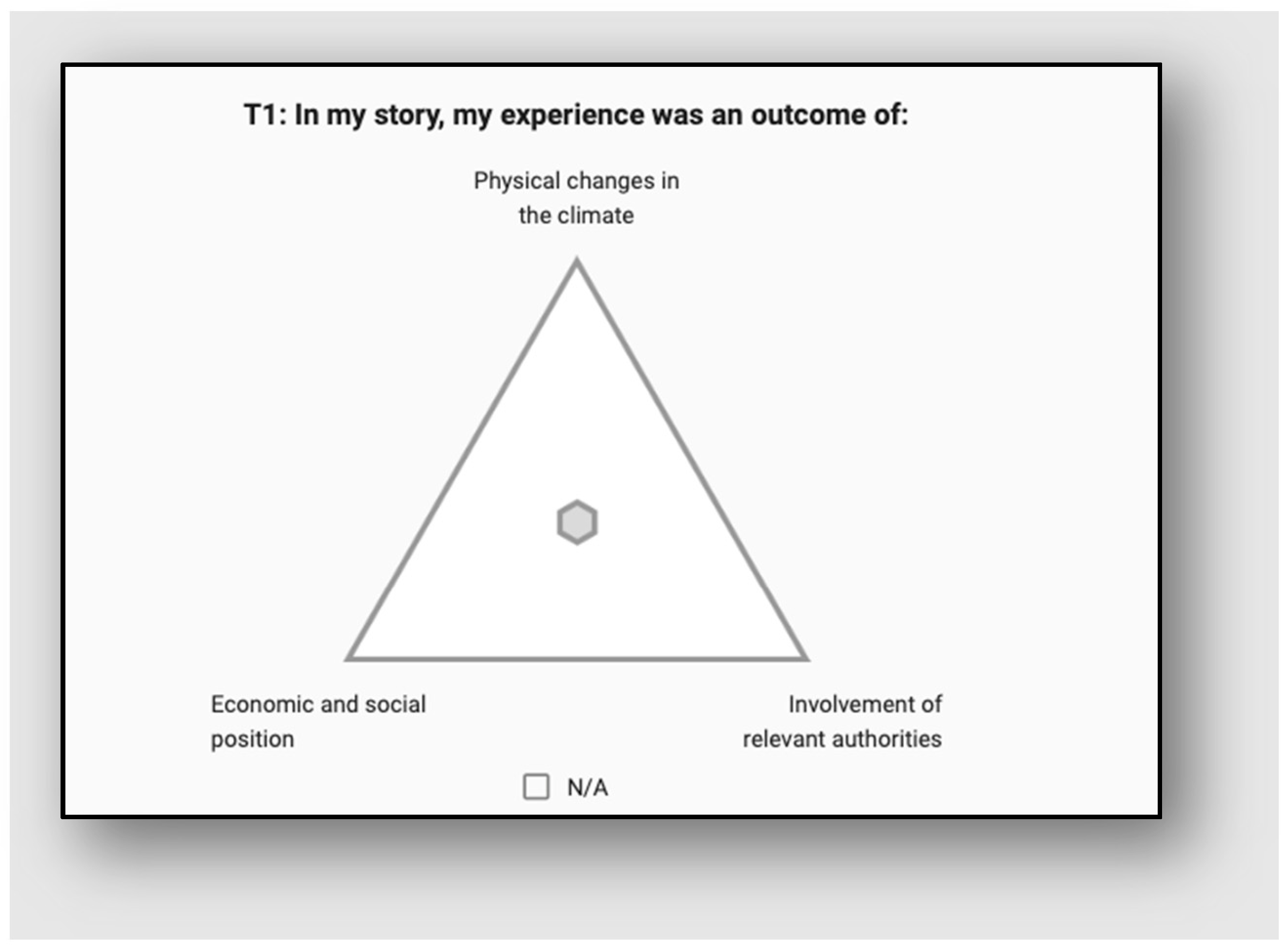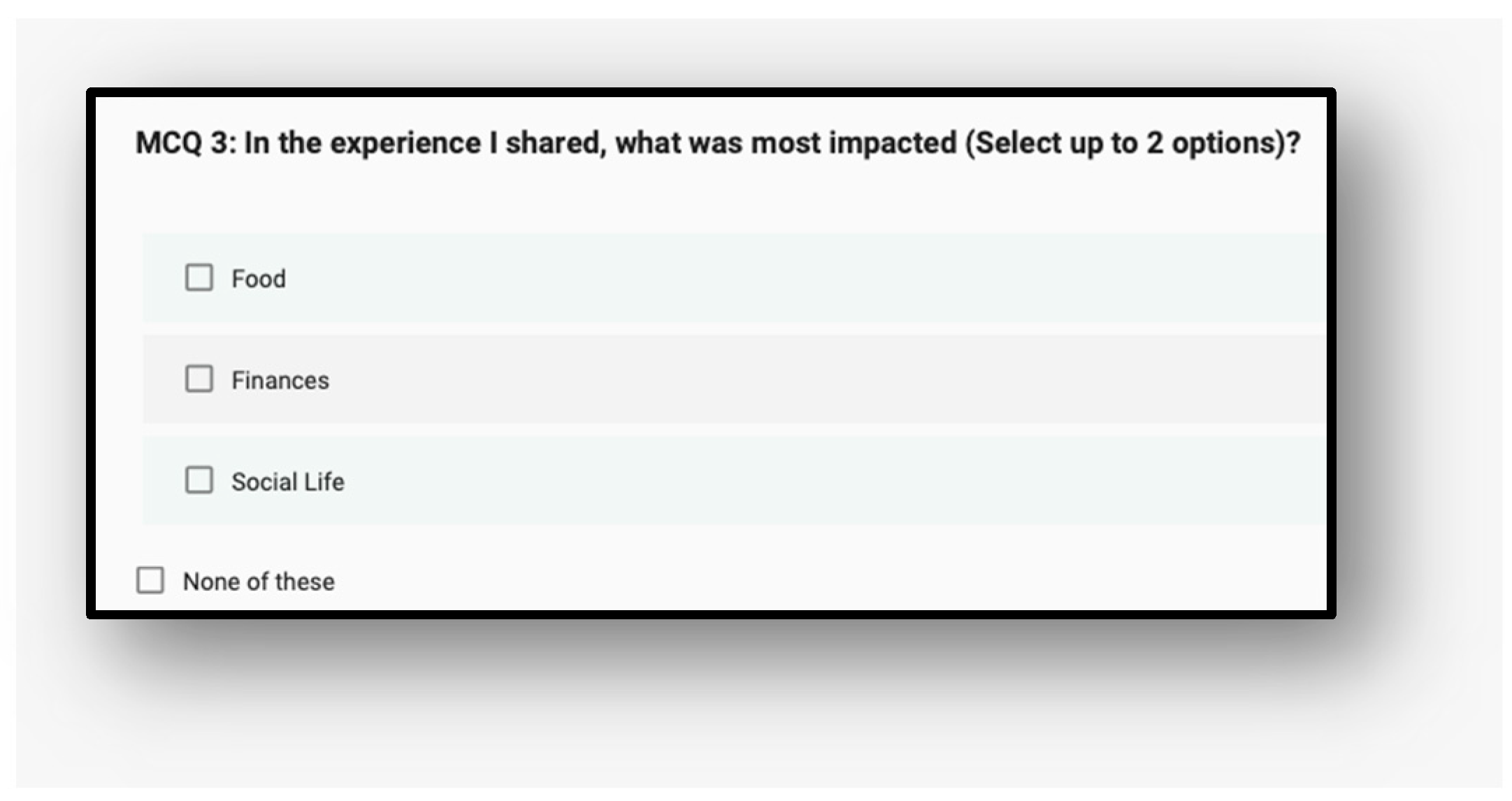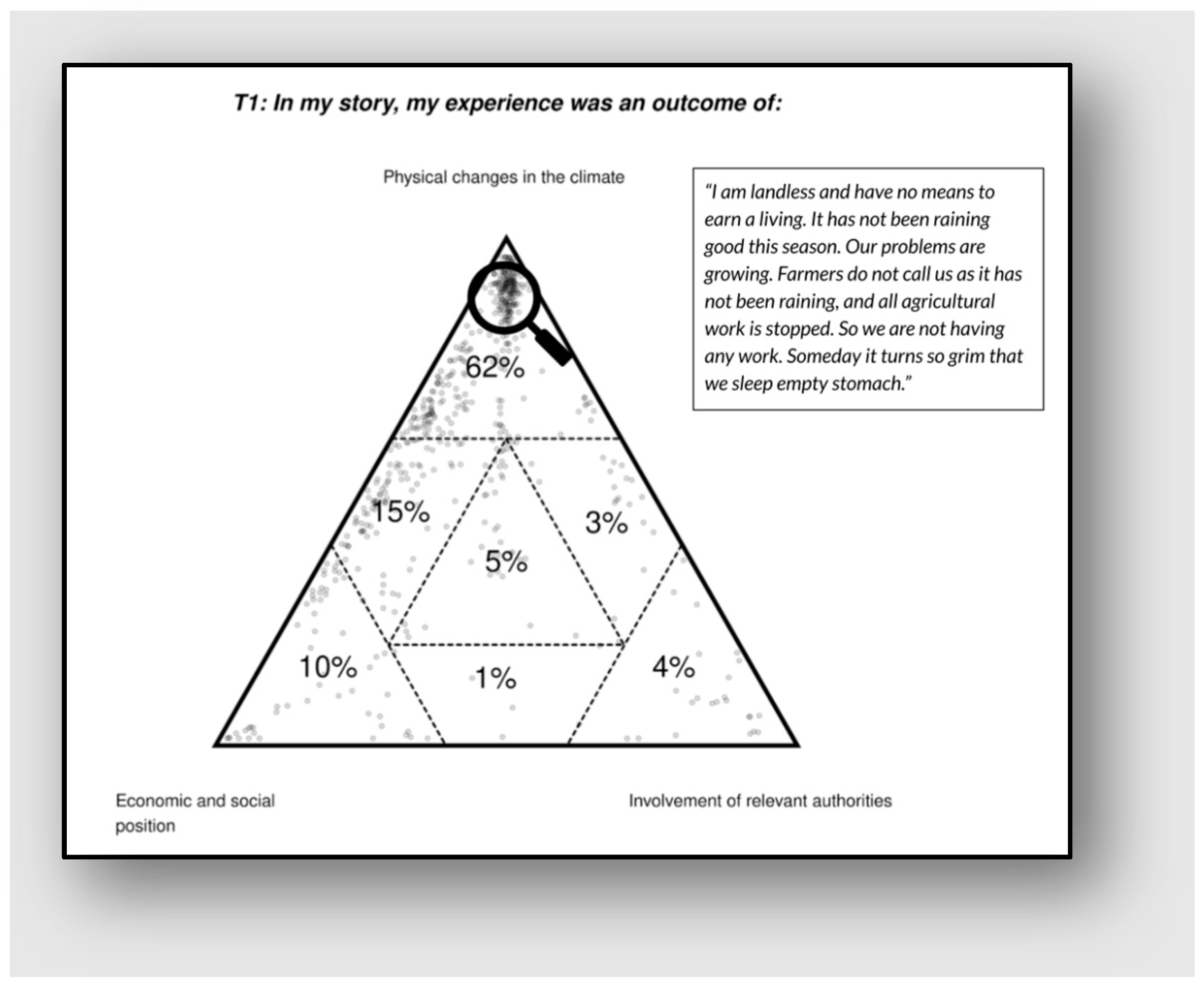Digital Ethnography? Our Experiences in the Use of SenseMaker for Understanding Gendered Climate Vulnerabilities amongst Marginalized Agrarian Communities
Abstract
1. Introduction
2. Methods: Conceptual Framework
2.1. Context
2.2. Transdisciplinarity
2.3. SenseMaker as a Transdisciplinary Tool in Theory and Practice
3. Results: Experience of Using SenseMaker: Promises, Challenges, and Implications
3.1. The Application of SenseMaker: Reflective Dialogues?
3.2. Performing Ethnography Digitally in Situations of a Digital Divide
3.3. Drawing Insights from SenseMaker Data
Prior hypotheses and assumptions
- The team assumed that individuals and groups facing persistent intersectional inequalities were disproportionately affected by climate change because they were excluded on multiple fronts, with marginalized women bearing the triple burden of climate change intersecting with poverty, gender norms, and their limited access to ownership of resources and services.
- Regarding stakeholders, the team expected that hierarchical and technocratic institutions that do not take intersectional inequalities into account will not be able to achieve deep structural reforms to mitigate climate change impacts.
Key findings from SenseMaker data
- Several social factors—gender, caste, class, and age—shape marginality and vulnerability: these factors must be considered in any intervention; failing to do so will result in exclusion, and gender alone is not a sufficient proxy. These factors also determine that the most marginalized women, as well as the most vulnerable, are largely excluded from empowerment initiatives, including agriculture and climate interventions.
- Women do not lead isolated lives, and their social relations with men (husbands, sons, and other male actors) are vital to their empowerment. Therefore, acting on these social relations, i.e., working with women, as well as engaging with men, is important for enabling women to emerge as entrepreneurs. Moreover, marginalization and pervasive gender norms affect men as much as they do women.
- Tertiary stakeholders—i.e., staff of government/private/civil society organizations who are at the point of contact with communities need to be equipped to understand the nature of social relations or intersecting inequalities and build technological expertise. The effectiveness of policies, actions, and finance for bringing about transformation on the ground would be enhanced if these actors’ capacities were strengthened.
3.4. Digitalizing Reflective Dialogues: A Step forward or backward
4. Discussion
5. Conclusions and Solutions to Explore
Author Contributions
Funding
Institutional Review Board Statement
Informed Consent Statement
Data Availability Statement
Acknowledgments
Conflicts of Interest
Appendix A. Sample Signifiers for the SenseMaker Signification Framework for Participant End-Users
- The narrative question
- Dyads
- Triads
- Multiple Choice Questions
- Stones (We decided not to use this signifier in our research because it would have made the framework overly lengthy).
Appendix A.1. Narrative Question

Appendix A.2. Dyads

Appendix A.3. Triads

Appendix A.4. Multiple Choice Questions

Appendix B. Background to Visualizations

References
- O’Neill, S.; Hulme, M.; Turnpenny, J.; Screen, J. Disciplines, Geography, and Gender in the Framing of Climate Change. Bull. Am. Meteorol. Soc. 2010, 91, 997–1002. [Google Scholar] [CrossRef]
- Tschakert, P.; Tutu, R.; Alcaro, A. Embodied Experiences of Environmental and Climatic Changes in Landscapes of Everyday Life in Ghana. Emot. Space Soc. 2013, 7, 13–25. [Google Scholar] [CrossRef]
- Waseem, M.; Khurshid, T.; Abbas, A.; Ahmad, I.; Javed, Z. Impact of Meteorological Drought on Agriculture Production at Different Scales in Punjab, Pakistan. J. Water Clim. Chang. 2021, 13, 113–124. [Google Scholar] [CrossRef]
- Aggarwal, P.; Jarvis, A.; Campbell, B.; Zougmoré, R.; Khatri-Chhetri, A.; Vermeulen, S.; Loboguerrero, A.M.; Sebastian, L.; Kinyangi, J.; Bonilla-Findji, O.; et al. The Climate-Smart Village Approach: Framework of an Integrative Strategy for Scaling up Adaptation Options in Agriculture. Ecol. Soc. 2018, 23, 14. [Google Scholar] [CrossRef]
- IPCC. Climate Change and Land: An IPCC Special Report on Climate Change, Desertification, Land Degradation, Sustainable Land Management, Food Security, and Greenhouse Gas Fluxes in Terrestrial Ecosystems. 2019. Available online: https://www.ipcc.ch/site/assets/uploads/sites/4/2021/07/210714-IPCCJ7230-SRCCL-Complete-BOOK-HRES.pdf (accessed on 15 December 2022).
- Hans, A.; Rao, N.; Prakash, A.; Patel, A. Engendering Climate Change Learnings from South Asia; Routledge: Oxfordshire, UK, 2021. [Google Scholar]
- Huyer, S. Closing the Gender Gap in Agriculture. Gend. Technol. Dev. 2016, 20, 105–116. [Google Scholar] [CrossRef]
- De Souza, K.; Kituyi, E.; Harvey, B.; Leone, M.; Murali, K.S.; Ford, J.D. Vulnerability to Climate Change in Three Hot Spots in Africa and Asia: Key Issues for Policy-Relevant Adaptation and Resilience-Building Research. Reg. Environ. Chang. 2015, 15, 747–753. [Google Scholar] [CrossRef]
- Geertz, C. Deep Hanging Out|Clifford Geertz. Available online: https://www.nybooks.com/articles/1998/10/22/deep-hanging-out/ (accessed on 13 February 2023).
- Magnat, V. Conducting Embodied Research at the Intersection of Performance Studies, Experimental Ethnography and Indigenous Methodologies. Anthropologica 2011, 53, 213–227. [Google Scholar]
- Markham, A. Doing Digital Ethnography in the Digital Age; RMIT University: Singapore, 2020. [Google Scholar] [CrossRef]
- Cleland, J.; MacLeod, A. Disruption in the Space-Time Continuum: Why Digital Ethnography Matters. Adv. Health Sci. Educ. Theory Pract. 2022, 27, 877–892. [Google Scholar] [CrossRef]
- Dicks, B.; Mason, B.; Coffey, A.; Atkinson, P. Qualitative Research and Hypermedia: Ethnography for the Digital Age; SAGE: New York, NY, USA, 2005. [Google Scholar]
- Murthy, D. Digital Ethnography: An Examination of the Use of New Technologies for Social Research. Sociology 2008, 42, 837–855. [Google Scholar] [CrossRef]
- Hine, C. Virtual Ethnography; SAGE: London, UK; Thousand Oaks, CA, USA, 2000. [Google Scholar]
- Herring, S.C. Computer-Mediated Discourse Analysis: An Approach to Researching Online Behavior. In Designing For Virtual Communities in the Service Of Learning; Learning in doing; Cambridge University Press: New York, NY, USA, 2004; pp. 338–376. [Google Scholar] [CrossRef]
- Underberg, N.M.; Zorn, E. Digital Ethnography: Anthropology, Narrative, and New Media; University of Texas Press: Austin, TA, USA, 2013. [Google Scholar]
- Van Dijk, J.A.G.M. The Deepening Divide: Inequality in the Information Society; Taylor & Francis: Abingdon, UK, 2005; p. 240. [Google Scholar] [CrossRef]
- Aguiar, C.M.; de Vasconcelos, J.P. What Is the Digital Divide? Internet Society: Reston, VA, USA. Available online: https://www.internetsociety.org/blog/2022/03/what-is-the-digital-divide/ (accessed on 13 February 2023).
- Coleman, S.; Normann, E. New Media and Social Inclusion; Hansard Society: London, UK, 2000. [Google Scholar]
- Kelly, W.W. Digital Technologies, Virtual Communities, Electronic Fieldwork: The Slow Social Science Adapts to High-Tech Japan. In eFieldnotes: The Makings of Anthropology in the Digital World; University of Pennsylvania Press: Philadelphia, PA, USA, 2016. [Google Scholar]
- Bailey, C.A. A Guide to Qualitative Field Research, 2nd ed.; Bailey, C.A., Ed.; Pine Forge: Thousand Oaks, CA, USA, 2007. [Google Scholar]
- Van der Merwe, S.E.; Biggs, R.; Preiser, R.; Cunningham, C.; Snowden, D.J.; O’Brien, K.; Jenal, M.; Vosloo, M.; Blignaut, S.; Goh, Z. Making Sense of Complexity: Using SenseMaker as a Research Tool. Systems 2019, 7, 25. [Google Scholar] [CrossRef]
- Lønsmann, D. Negotiating Positionality in Ethnographic Investigations of Workplace Settings: Student, Consultant or Confidante? In The Ins and Outs of Business and Professional Discourse Research: Reflections on Interacting with the Workplace; Alessi, G.M., Jacobs, G., Eds.; Communicating in Professions and Organizations; Palgrave Macmillan UK: London, UK, 2016; pp. 13–36. [Google Scholar] [CrossRef]
- Bihar State Action Plan on Climate Change ‘Building Resilience through Development’; Government of Bihar: Patna, India. 2015. Available online: http://moef.gov.in/wp-content/uploads/2017/08/Bihar-State-Action-Plan-on-Climate-Change-2.pdf (accessed on 2 January 2023).
- Mohanty, R.N. Chronic Poverty and Social Conflict in Bihar. SSRN Electron. J. 2005, 1–24. [Google Scholar] [CrossRef]
- Agarwal, T.; Goel, P.A.; Gartaula, H.; Rai, M.; Bijarniya, D.; Rahut, D.B.; Jat, M.L. Gendered impacts of climate-smart agriculture on household food security and labor migration: Insights from Bihar, India. Int. J. Clim. Chang. Strateg. Manag. 2022, 14, 1–19. [Google Scholar] [CrossRef]
- Aheeyar, M.; de Silva, S.; Senaratna-Sellamuttu, S.; Arulingam, I. Unpacking Barriers to Socially Inclusive Weather Index Insurance: Towards a Framework for Inclusion. Water 2019, 11, 2235. [Google Scholar] [CrossRef]
- United Nations. World Social Report 2020: Inequality in a Rapidly Changing World; UN: New York, NY, USA, 2020. [Google Scholar] [CrossRef]
- Kroll-Zeldin, O. Colonialism. 2016. Available online: https://www.oxfordbibliographies.com/display/document/obo-9780199766567/obo-9780199766567-0139.xml (accessed on 15 February 2023).
- Lewis, D. Anthropology and Colonialism. Curr. Anthropol. 1973, 14, 581–602. [Google Scholar] [CrossRef]
- Merriam, S.B.; Johnson-Bailey, J.; Lee, M.-Y.; Kee, Y.; Ntseane, G.; Muhamad, M. Power and Positionality: Negotiating Insider/Outsider Status within and across Cultures. Int. J. Lifelong Educ. 2001, 20, 405–416. [Google Scholar] [CrossRef]
- Hesjedal, M.B.; Åm, H. Making Sense of Transdisciplinarity: Interpreting Science Policy in a Biotechnology Centre. Sci. Public Policy 2023, 50, 219–229. [Google Scholar] [CrossRef]
- Snowden, D. Appendix 2: Narrative Research. 2010. Available online: https://narrate.typepad.com/100816-narrative-research_snowden-final.pdf (accessed on 16 December 2022).
- Wakeford, T.; Rodriguez, J. Participatory Action Research: Towards a More Fruitful Knowledge; University of Exeter: Exeter, UK, 2019. [Google Scholar]
- Seidl, R.; Brand, F.S.; Stauffacher, M.; Krütli, P.; Le, Q.B.; Spörri, A.; Meylan, G.; Moser, C.; González, M.B.; Scholz, R.W. Science with Society in the Anthropocene. AMBIO 2013, 42, 5–12. [Google Scholar] [CrossRef]
- Ziervogel, G.; Enqvist, J.; Metelerkamp, L.; van Breda, J. Supporting Transformative Climate Adaptation: Community-Level Capacity Building and Knowledge Co-Creation in South Africa. Clim. Policy 2022, 22, 607–622. [Google Scholar] [CrossRef]
- Toyama, K. Geek Heresy: Rescuing Social Change from the Cult of Technology; PublicAffairs: New York, NY, USA, 2015. [Google Scholar]
- D’Ignazio, C.; Klein, L.F. Data Feminism; The MIT Press: Cambridge, MA, USA, 2020. [Google Scholar]
- Georgalakis, J. Shaping Policy with Evidence (Online); Institute of Development Studies: Falmer, UK. Available online: https://www.ids.ac.uk/specialist-short-courses/shaping-policy-with-evidence/ (accessed on 14 February 2023).
- Rigolot, C. Transdisciplinarity as a Discipline and a Way of Being: Complementarities and Creative Tensions. Humanit. Soc. Sci. Commun. 2020, 7, 7. [Google Scholar] [CrossRef]
- Pike, K.L. Etic and Emic Standpoints for the Description of Behavior. In Language in Relation to a Unified Theory of the Structure of Human Behavior, 2nd ed.; Mouton & Co.: The Hague, The Netherlands, 1967; pp. 37–72. [Google Scholar] [CrossRef]
- Young, J. On Insiders (Emic) and Outsiders (Etic): Views of Self, and Othering. Syst. Pract. Action Res. 2005, 18, 151–162. [Google Scholar] [CrossRef]
- Milne, K.M.G. Can Sense-Making Tools Inform Adaptation Policy? A Practitioner’s Perspective. Ecol. Soc. 2015, 20, 66. [Google Scholar] [CrossRef]
- van Breda, J.; Swilling, M. The Guiding Logics and Principles for Designing Emergent Transdisciplinary Research Processes: Learning Experiences and Reflections from a Transdisciplinary Urban Case Study in Enkanini Informal Settlement, South Africa. Sustain. Sci. 2019, 14, 823–841. [Google Scholar] [CrossRef]
- Lincoln, Y. Engaging Sympathies: Relationships between Action Research and Social Constructivism. In The SAGE Handbook of Action Research: Participative Inquiry and Practice; SAGE Publications: London, UK; Thousand Oaks, CA, USA, 2008; pp. 124–132. [Google Scholar]
- Bihar Population Census 2011, Bihar Religion, Literacy, Sex Ratio—Census India. Available online: https://www.censusindia.co.in/states/bihar (accessed on 14 February 2023).
- Bartels, S.A.; Michael, S.; Vahedi, L.; Collier, A.; Kelly, J.; Davison, C.; Scott, J.; Parmar, P.; Geara, P. SenseMaker® as a Monitoring and Evaluation Tool to Provide New Insights on Gender-Based Violence Programs and Services in Lebanon. Eval. Program Plann. 2019, 77, 101715. [Google Scholar] [CrossRef] [PubMed]
- Hemelrijck, A.V. Methodological Reflections Following the Second PIALA Pilot in Ghana; IDS: Falmer, UK, 2016. [Google Scholar]
- Hemelrijck, A.V.; Goh, Z. Methodological Reflections on the Use of SenseMaker® for Impact M&E of Adaptation in the Mekong Delta (AMD); IFAD: Roma, Italy, 2015. [Google Scholar]
- Boellstorff, T. Rethinking Digital Anthropology. In Digital Ethnography; Bloomsberry Academic: London, UK, 2013. [Google Scholar]
- Fisher, E.; Hellin, J.; Greatrex, H.; Jensen, N. Index Insurance and Climate Risk Management: Addressing Social Equity. Dev. Policy Rev. 2019, 37, 581–602. [Google Scholar] [CrossRef]
- Wamsler, C.; Osberg, G.; Panagiotou, A.; Smith, B.; Stanbridge, P.; Osika, W.; Mundaca, L. Meaning-making in a context of climate change: Supporting agency and political engagement. Clim. Policy 2022, 1–16. [Google Scholar] [CrossRef]
- The Cynefin Centre for Applied Complexity. SenseMaker®. Available online: https://thecynefin.co/about-sensemaker/ (accessed on 27 March 2023).
Disclaimer/Publisher’s Note: The statements, opinions and data contained in all publications are solely those of the individual author(s) and contributor(s) and not of MDPI and/or the editor(s). MDPI and/or the editor(s) disclaim responsibility for any injury to people or property resulting from any ideas, methods, instructions or products referred to in the content. |
© 2023 by the authors. Licensee MDPI, Basel, Switzerland. This article is an open access article distributed under the terms and conditions of the Creative Commons Attribution (CC BY) license (https://creativecommons.org/licenses/by/4.0/).
Share and Cite
Joshi, D.; Panagiotou, A.; Bisht, M.; Udalagama, U.; Schindler, A. Digital Ethnography? Our Experiences in the Use of SenseMaker for Understanding Gendered Climate Vulnerabilities amongst Marginalized Agrarian Communities. Sustainability 2023, 15, 7196. https://doi.org/10.3390/su15097196
Joshi D, Panagiotou A, Bisht M, Udalagama U, Schindler A. Digital Ethnography? Our Experiences in the Use of SenseMaker for Understanding Gendered Climate Vulnerabilities amongst Marginalized Agrarian Communities. Sustainability. 2023; 15(9):7196. https://doi.org/10.3390/su15097196
Chicago/Turabian StyleJoshi, Deepa, Anna Panagiotou, Meera Bisht, Upandha Udalagama, and Alexandra Schindler. 2023. "Digital Ethnography? Our Experiences in the Use of SenseMaker for Understanding Gendered Climate Vulnerabilities amongst Marginalized Agrarian Communities" Sustainability 15, no. 9: 7196. https://doi.org/10.3390/su15097196
APA StyleJoshi, D., Panagiotou, A., Bisht, M., Udalagama, U., & Schindler, A. (2023). Digital Ethnography? Our Experiences in the Use of SenseMaker for Understanding Gendered Climate Vulnerabilities amongst Marginalized Agrarian Communities. Sustainability, 15(9), 7196. https://doi.org/10.3390/su15097196




